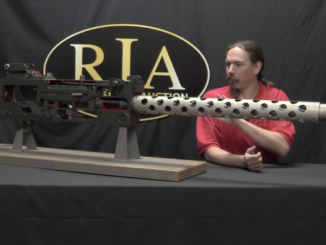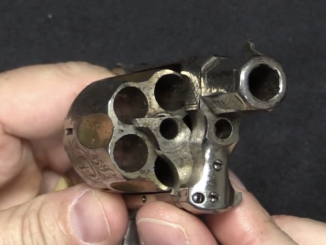When the Massachusetts Arms Company initially produced the Wesson & Leavitt Dragoon revolver, they quickly incurred the wrath of the colt company. Those initial revolvers violated several Colt patents. The resulting lawsuit forced the end of production of the Dragoons, and the company decided to redesign the guns to avoid the Colt patents. The result was this .31-caliber belt model revolver, as well as a similar .28 caliber pocket model.
To make the guns legal, the hammer was no longer connected to movement of the cylinder. Instead a release button was located inside the trigger guard. After firing, the user would press this to release the cylinder and then manually rotate it to the next chamber. In addition, the metallic cap priming was replaced by a Maynard tape system (used under license, unlike the Colt patents!).
Not more than about a thousand of these revolvers were made, as they were obviously technically inferior to the Colt guns of the time. However, the small sales, combined with other guns, were enough to hold the Massachusetts Arms Company above water financially until 1857, when the Colt patents expired.




Just enough to survive… Sounds like the Battle of Britain. The British invested just enough in new tech and aircraft to keep themselves from being conquered while the Germans invested just a few thousand marks short on the concept of strategic bombardment-or am I wrong?
In the case of the Massachusetts Arms Company, once the patents for Colt expired, there was no need to worry about getting sued over a hammer-induced indexing process. But no thanks to Rollin White, bored-through cylinders for the firm were not going to be viable for a long time… unless I’ve made a mistake somewhere.
“the Germans invested just a few thousand marks short on the concept of strategic bombardment-or am I wrong”
In Germany Walther Wever was advocate of four-engine bombers
https://en.wikipedia.org/wiki/Walther_Wever_(general)
Dornier Do 19 and Junkers Ju 89 were developed, however after his death in air crash in 1936, Ernst Udet become more influential to Luftwaffe aeroplanes development, he prefer dive-bomber and medium-bomber so this aeroplanes were developed (Junkers Ju 87, Heinkel He 111, Dornier Do 17, Junkers Ju 88)
I know you couldn’t get the gun apart, do you know what the back of the cylinder looks like? What I’m wondering is, without a percussion cap and nipple to seal off the back of the cylinder, how did they keep the powder from leaking out the back of the cylinder, especially in the tape primer area?
I read somewhere that you could get extra cylinders fitted to Colt percussion revolvers and they could be switched in and out like a ‘magazine’ to speed up reloading. don’t know if that’s true or not.
love those videos, keep up the good work!
I’ve heard of it being done, don’t know if it was widespread practice, but it was definitely possible and alot faster than reloading all the chambers.
It’s pretty easy to switch out the cylinder on a Colt C&B. But it does take time, and there are issues of either the caps falling from the nipples, or having to cap the cylinder. It’s even easier to carry that cylinder in a second gun. This is the origin of the Two Gun Cowboy, not blazing away with both hands, a la Hollywood.
What a cute little gun!
Regarding the percussion caps tape un-winding (Maynard tape system) – cocking the hummer rotates the winded type constant angle for each hummer cocking. The type had to emerge out of the ‘drum’ in a constant step in order to place the next percussion cap in the right place to be stroke by the hummer.
If the type had been rolled more than one pitch then such a thing couldn’t work, how did they do it?
Yoel
Looking at the patent drawings online, the caps are not perforated like the toy ones we had as kids. But there appears to be a hand and a star wheel to advance the caps a fixed increment.
IIRC from reading the Model 1855 Rifle-Musket also used Maynard caps. The caps were considered a major PITA, and the weapon was generally used with “old fashioned” percussion caps.
“Bumps” on those tapes were more articulated than in tapes for the toy pistols(which are almost flat), so i think the could have some indexing function.